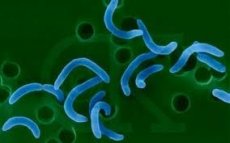Medical expert of the article
New publications
Coxsackie viruses
Last reviewed: 08.07.2025

All iLive content is medically reviewed or fact checked to ensure as much factual accuracy as possible.
We have strict sourcing guidelines and only link to reputable media sites, academic research institutions and, whenever possible, medically peer reviewed studies. Note that the numbers in parentheses ([1], [2], etc.) are clickable links to these studies.
If you feel that any of our content is inaccurate, out-of-date, or otherwise questionable, please select it and press Ctrl + Enter.

In 1948, G. Doldorff and G. Sickles isolated a virus from the intestinal contents of children with poliomyelitis-like disease that was similar to polioviruses, but differed from them not only in antigenic properties, but also in virulence for newborn mice (polioviruses types I and III are pathogenic only for monkeys, poliovirus type II can be adapted to cotton rats). This virus was isolated in the town of Coxsackie (New York State), so G. Doldorff proposed to temporarily call this and similar viruses the Coxsackie group viruses. This name has survived to this day.
As it turned out, Coxsackie viruses are widespread in nature and are represented by many variants. In terms of virological and epidemiological properties, they are in many ways similar to polioviruses and play a significant role in human pathology. It should be noted that Coxsackie viruses are the most cardiotropic of all enteroviruses. In 20-40% of patients under 20 years of age, Coxsackie infection is complicated by myocarditis. Coxsackie viruses are represented by two groups: Coxsackie A group includes 23 serovariants (A1-A22, 24); Coxsackie B group includes 6 serovariants (B1-B6).
Coxsackie viruses of group A cause flaccid paralysis in newborn mice due to damage to skeletal muscles. In contrast, Coxsackie B viruses cause damage to the central nervous system in newborn mice, and changes in muscles are weakly expressed. Necrosis of brown interscapular fat is characteristic of the infection. In addition, some serovars of Coxsackie A (20, 21, 24) and all serovars of Coxsackie B have hemagglutinating properties, unlike polioviruses.
It was also believed that Coxsackie A viruses, unlike Coxsackie B viruses, do not reproduce in human cell cultures. But it turned out that a number of Coxsackie A serovars, like Coxsackie B and polioviruses, are capable of reproducing in human cell cultures. In addition to poliomyelitis-like diseases, sometimes accompanied by paralysis, Coxsackie A and B viruses can cause various other diseases with unique clinical symptoms in humans:
- aseptic meningitis,
- epidemic myalgia (Bornholm disease),
- herpangina,
- minor illness,
- gastroenteritis,
- acute respiratory diseases,
- myocarditis (cardiotropism is more pronounced in Coxsackie viruses).
- hand, foot and mouth syndrome.
Along with rubella and mumps viruses, Coxsackie B viruses, causing pancreatitis, can play a significant role in the etiology of diabetes. Intrauterine transmission of Coxsackie viruses from a mother with a persistent form of Coxsackie infection to the fetus is also possible - congenital chronic form of Coxsackie infection, often against the background of congenital immunodeficiency.
 [ 1 ], [ 2 ], [ 3 ], [ 4 ], [ 5 ], [ 6 ], [ 7 ], [ 8 ], [ 9 ], [ 10 ], [ 11 ], [ 12 ], [ 13 ], [ 14 ]
[ 1 ], [ 2 ], [ 3 ], [ 4 ], [ 5 ], [ 6 ], [ 7 ], [ 8 ], [ 9 ], [ 10 ], [ 11 ], [ 12 ], [ 13 ], [ 14 ]

